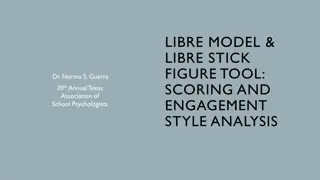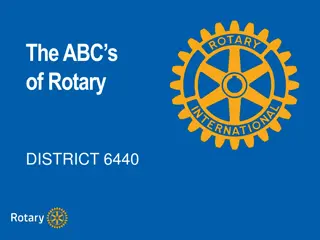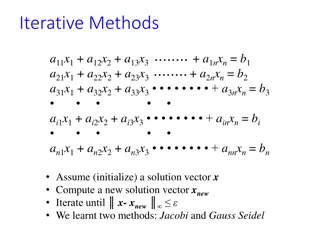Understanding Iterative Solvers in MODFLOW
In this content, you will learn about the working of iterative solvers, solver parameters, troubleshooting convergence issues, and various solver algorithms in MODFLOW. The iterative tweaking of starting head values, different solver codes like SIP, PCG2, GMG, and their characteristics are explained. Key parameters such as maximum iterations, convergence tolerance, and acceleration parameter are discussed to understand their impact on model convergence. Real-life examples and tips for efficient solver usage are also provided.
Download Presentation

Please find below an Image/Link to download the presentation.
The content on the website is provided AS IS for your information and personal use only. It may not be sold, licensed, or shared on other websites without obtaining consent from the author. Download presentation by click this link. If you encounter any issues during the download, it is possible that the publisher has removed the file from their server.
E N D
Presentation Transcript
Understand how an iterative solver works Know the basic solver parameters and understand how they impact the solver Understand how and why solvers don t converge Know how to troubleshoot solver convergence problems
Starting head values are iteratively tweaked until head differences satisfy governing equation Each solver uses a different algorithm to modify heads Sometimes we need to switch solvers or tweak solver parameters to get a model to converge
Code Name Notes SIP Strongly Implicit Procedure One of the original solvers. Simple but can have speed and stability issues. SSOR Slice-Successive Over- Relaxation One of the original solvers. Can result in incorrect solutions. Not recommended. PCG2 Pre-Conditioned Conjugate Gradient Good all-around solver. Default solver in GMS. PCGN PCG with Improved Non- Linear Control Newer version of PCG2 package. More stable under some conditions. NWT Newton Solver Used with MODFLOW-NWT. Best for wetting/drying problems. GMG Geometric Multi-Grid Multi-grid solver requires more memory but results in faster solution. USGS version. DE4 Direct Solver Direct matrix solution (non-iterative). LMG/ SAMG Algebraic Multi-Grid Commercial multi-grid solvers. Outstanding performance but extra cost.
Max number of iterations Iteration stops at this point regardless of convergence Convergence tolerance Iteration stops if max head change is less than this amount Acceleration parameter Controls the amount of adjustment made to heads at each iteration Options =1.0 Default value. Head changes standard amount determined by solver <1.0 Head change is reduced. Improves convergence but results in slower solution >1.0 Converges faster but may be unstable
Using MODFLOW 2000 Run on Intel Core2 Quad CPU 2.4 GHz Initial condition the same for all solvers Starting heads = constant value OR Starting heads = top of grid HCLOSE = .001 RCLOSE = .001 (all solvers except SIP)
Woburn model HUF package 8 layers 152,880 cells SIP PCG2 SAMG GMG 980 sec* 64 sec 39 sec 87 sec *had to reduce acc. param to 0.25 in order to converge
Head = 110 m One layer model Unconfined 96,000 cells Injection Wells SIP PCG2 SAMG GMG Extraction Wells 5 sec* 6 sec 2.5 sec 6 sec *had to reduce acc. param to 0.1 in order to converge, large flow budget error Head = 90 m
Head = 110 m Same as previous Increased num cells to 216,000 Injection Wells SIP PCG2 SAMG GMG 16 sec* 15 sec 6 sec 13 sec Extraction Wells *had to reduce acc. param to 0.05 in order to converge, large flow budget error Head = 90 m
Head = 110 m Same as previous Changed to transient 4 stress periods, 10 time steps Injection Wells SIP PCG2 120 sec SAMG 55 sec GMG 110 sec Extraction Wells 50 sec* Head = 90 m *had to reduce acc. param to 0.05 in order to converge, large flow budget error
Two layer model Unconfined Steady state 600,000 cells SIP PCG2 SAMG GMG 587 sec* 56 sec 29 sec 40 sec *had to reduce acc. param to 0.05 in order to converge
Num. Cells # Layers Trans. SIP* PCG2 SAMG GMG 152,880 8 No 980 64 87 39 96,000 1 No 5 6 6 2.5 216,000 1 No 16 15 13 6 216,000 1 Yes 120 55 110 50* 600,000 2 No 587 56 40 29 *had to reduce acc. param in order to converge, some of the models had large flow budget error
Improper boundary conditions Wetting and drying issues Highly sensitive model Etc. Improper aquifer properties Unbalanced flow budget Improper initial conditions
1) Review command line output from MODFLOW (Run MODFLOW Window) 2) Run Model Checker 3) Look in MODFLOW output file (*.OUT)
With most solvers, if head drops below bottom of cell, the cell becomes dry and is turned off Can occur during any portion (iteration) of solution process, not just at end of time step Causes Head overshoot Model parameters Transient conditions
Starting head Cell goes dry , and is turned off during remainder of simulation Solver guesses how much to adjust head downward Final head Final head Bottom elevation Bottom elevation Computed head Initial Condition After One Iteration
Starting head Starting head is closer to final head Iteration #1 Starting head Iteration #2 Iteration #3 Final head Final head Bottom elevation Bottom elevation Reduce Acceleration Parameter Improve Starting Head Estimates
In many cases, cells are going dry due to: Recharge too low K too high Etc. Solution Adjust parameters to better calibrate model
Transient conditions will cause heads to fluctuate and cells to go dry Particularly an issue for multi-layer models
Option available in all flow packages (BCF, LPF, HUF) Off by default Rewetting increases solution time May case solution to be less stable
New version of MODFLOW released in 2011 Designed to solve nonlinear problems due to unconfined conditions or nonlinear boundary conditions Best solution for wetting and drying























